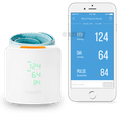

iHealth View Wireless Wrist Blood Pressure Monitor
MRP
₹9300Inclusive of all taxes
of1 Unit
SOLD OUT
Information about iHealth View Wireless Wrist Blood Pressure Monitor
iHealth View Wireless Wrist Blood Pressure Monitor Kit includes:
- Wireless Blood Pressure Wrist Monitor (1 unit)
- Owner’s Manual (1 unit)
- Quick Start Guide (1 unit)
- Charging cable (1 unit)
- Travel case (1 unit)
iHealth View Wireless Wrist Blood Pressure Monitor is clinically tested and FDA approved monitor that gives reliable readings at home or on the go.
Use: To monitor blood glucose level
Salient features of iHealth View Wireless Wrist Blood Pressure Monitor:
- Intelligent Display:
This smart wireless wrist blood pressure monitor automatically detects and directs optimal arm position on the unit’s display for precise results.
- Secure Sharing:
Blood pressure readings are stored on the secure, free, HIPAA compliant iHealth Cloud. Monitor blood pressure and pulse trends with intuitive charts and share data with your doctor in PDF or spreadsheet format right from your smartphone, tablet or computer.
Specifications
Classification: Internally powered, Type BF applied part, IPX0, No AP or APG, Continuous operation
Wireless communication: Bluetooth V3.0+EDR Class 2 SPP
Measuring method: Oscillometric, automatic inflation and measurement
Indication:
Diabetes Mellitus
Frequently Asked Questions
Q. What is the need to monitor blood glucose (blood sugar) level in the body?
Monitoring blood glucose level is important since it gives a valuable information to the individual so that he can manage his blood glucose level on daily basis.
Q. Is this device reliable for self-monitoring of blood glucose level?
Yes, this device is reliable for self-monitoring of blood glucose level in the body. The range of internationally accepted standard error for blood sugar values estimated by glucometer is 10-15% i.e about 10mg/dl up or down from standard value.
Q. How do I check whether the glucometer is calibrated or not?
Usually, the glucose test strip comes with a unique code so the first step should be to turn the meter on and check whether the code on the test strip and that on the glucometer is same. If codes do not match it indicates that the glucometer is not calibrated.
Q. What is the general procedure for calibrating any glucometer either automatic or manually?
If the code mentioned on the test strip does not match with the code mentioned on the glucometer then it should be calibrated using the following procedure:
1) Meter with Manual Calibration:
- If the meter is used before then there will be a coding number. See the code number on the test strip label and insert the strip in the meter and enter the code number in the meter by moving the ‘up’ or ‘down’ arrow to calibrate it.
- If the glucometer is new, instead of a coding number, there will be dashes.
2) Meter with Automatic Calibration:
- Turn on the blood glucose meter by pressing the power button
- Open the meter and insert the test strip and close it
- Then the meter will now be calibrated
Q. Is there any difference between checking blood glucose using a glucometer and from a lab?
The glucometer value gives an estimate of blood sugar in capillary blood while the lab value gives an estimate of blood sugar in the venous blood. In capillary blood, the amount of glucose is less as compared to the venous blood so the difference is slightly elevated for a glucometer reading.
Q. How frequently should a diabetic patient test his blood sugar in case of other diseased conditions like any infection, fever etc?
In a diabetic patient, such problems may get complicated easily, in that case, the anti-diabetic regimen should not be discontinued. Blood glucose level should be tested more often and if serious problems like recurrent vomiting, problem in taking food orally or unstable blood glucose level (high or less than 70mg/dl) starts to occur then immediately visit a doctor.
Q. How frequently should I monitor the increased dose of drug/insulin by the doctor?
After an increased dose, the monitoring should be done more frequently to avoid facing any critical situation. Especially in case of new drug initiation or multi-drug therapy with insulin.
Q. Can I use one blood glucose test strip more than once?
It is recommended that always a new test strip should be used for the test.
Q. The battery of glucometer can be charged or need to be replaced?
The battery of the glucometer needs to be replaced.
- Wireless Blood Pressure Wrist Monitor (1 unit)
- Owner’s Manual (1 unit)
- Quick Start Guide (1 unit)
- Charging cable (1 unit)
- Travel case (1 unit)
iHealth View Wireless Wrist Blood Pressure Monitor is clinically tested and FDA approved monitor that gives reliable readings at home or on the go.
Use: To monitor blood glucose level
Salient features of iHealth View Wireless Wrist Blood Pressure Monitor:
- Intelligent Display:
This smart wireless wrist blood pressure monitor automatically detects and directs optimal arm position on the unit’s display for precise results.
- Secure Sharing:
Blood pressure readings are stored on the secure, free, HIPAA compliant iHealth Cloud. Monitor blood pressure and pulse trends with intuitive charts and share data with your doctor in PDF or spreadsheet format right from your smartphone, tablet or computer.
Specifications
Classification: Internally powered, Type BF applied part, IPX0, No AP or APG, Continuous operation
Wireless communication: Bluetooth V3.0+EDR Class 2 SPP
Measuring method: Oscillometric, automatic inflation and measurement
Indication:
Diabetes Mellitus
Frequently Asked Questions
Q. What is the need to monitor blood glucose (blood sugar) level in the body?
Monitoring blood glucose level is important since it gives a valuable information to the individual so that he can manage his blood glucose level on daily basis.
Q. Is this device reliable for self-monitoring of blood glucose level?
Yes, this device is reliable for self-monitoring of blood glucose level in the body. The range of internationally accepted standard error for blood sugar values estimated by glucometer is 10-15% i.e about 10mg/dl up or down from standard value.
Q. How do I check whether the glucometer is calibrated or not?
Usually, the glucose test strip comes with a unique code so the first step should be to turn the meter on and check whether the code on the test strip and that on the glucometer is same. If codes do not match it indicates that the glucometer is not calibrated.
Q. What is the general procedure for calibrating any glucometer either automatic or manually?
If the code mentioned on the test strip does not match with the code mentioned on the glucometer then it should be calibrated using the following procedure:
1) Meter with Manual Calibration:
- If the meter is used before then there will be a coding number. See the code number on the test strip label and insert the strip in the meter and enter the code number in the meter by moving the ‘up’ or ‘down’ arrow to calibrate it.
- If the glucometer is new, instead of a coding number, there will be dashes.
2) Meter with Automatic Calibration:
- Turn on the blood glucose meter by pressing the power button
- Open the meter and insert the test strip and close it
- Then the meter will now be calibrated
Q. Is there any difference between checking blood glucose using a glucometer and from a lab?
The glucometer value gives an estimate of blood sugar in capillary blood while the lab value gives an estimate of blood sugar in the venous blood. In capillary blood, the amount of glucose is less as compared to the venous blood so the difference is slightly elevated for a glucometer reading.
Q. How frequently should a diabetic patient test his blood sugar in case of other diseased conditions like any infection, fever etc?
In a diabetic patient, such problems may get complicated easily, in that case, the anti-diabetic regimen should not be discontinued. Blood glucose level should be tested more often and if serious problems like recurrent vomiting, problem in taking food orally or unstable blood glucose level (high or less than 70mg/dl) starts to occur then immediately visit a doctor.
Q. How frequently should I monitor the increased dose of drug/insulin by the doctor?
After an increased dose, the monitoring should be done more frequently to avoid facing any critical situation. Especially in case of new drug initiation or multi-drug therapy with insulin.
Q. Can I use one blood glucose test strip more than once?
It is recommended that always a new test strip should be used for the test.
Q. The battery of glucometer can be charged or need to be replaced?
The battery of the glucometer needs to be replaced.
Country of origin: India
 Authentic Products
Authentic Products Great Savings
Great Savings Home Delivery
Home Delivery





